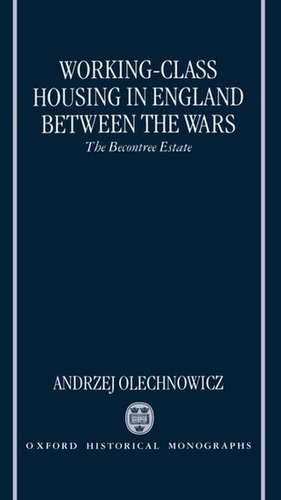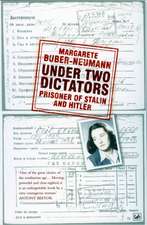Working-Class Housing in England between the Wars: The Becontree Estate: Oxford Historical Monographs
Autor Andrzej Olechnowiczen Limba Engleză Hardback – 9 ian 1997
Din seria Oxford Historical Monographs
- 19%
 Preț: 497.26 lei
Preț: 497.26 lei - 12%
 Preț: 310.34 lei
Preț: 310.34 lei - 30%
 Preț: 539.99 lei
Preț: 539.99 lei - 15%
 Preț: 244.01 lei
Preț: 244.01 lei - 13%
 Preț: 532.53 lei
Preț: 532.53 lei - 30%
 Preț: 499.46 lei
Preț: 499.46 lei - 30%
 Preț: 497.67 lei
Preț: 497.67 lei - 30%
 Preț: 499.18 lei
Preț: 499.18 lei - 30%
 Preț: 498.68 lei
Preț: 498.68 lei - 30%
 Preț: 604.98 lei
Preț: 604.98 lei - 30%
 Preț: 497.63 lei
Preț: 497.63 lei - 24%
 Preț: 496.31 lei
Preț: 496.31 lei - 30%
 Preț: 498.68 lei
Preț: 498.68 lei - 22%
 Preț: 497.81 lei
Preț: 497.81 lei - 25%
 Preț: 556.27 lei
Preț: 556.27 lei - 14%
 Preț: 539.57 lei
Preț: 539.57 lei - 30%
 Preț: 500.29 lei
Preț: 500.29 lei - 13%
 Preț: 533.57 lei
Preț: 533.57 lei - 25%
 Preț: 569.72 lei
Preț: 569.72 lei - 30%
 Preț: 610.82 lei
Preț: 610.82 lei - 34%
 Preț: 1153.34 lei
Preț: 1153.34 lei - 51%
 Preț: 614.88 lei
Preț: 614.88 lei - 34%
 Preț: 1195.31 lei
Preț: 1195.31 lei - 34%
 Preț: 1035.84 lei
Preț: 1035.84 lei - 34%
 Preț: 1006.40 lei
Preț: 1006.40 lei - 29%
 Preț: 864.39 lei
Preț: 864.39 lei - 34%
 Preț: 1160.09 lei
Preț: 1160.09 lei - 34%
 Preț: 1432.67 lei
Preț: 1432.67 lei - 31%
 Preț: 328.46 lei
Preț: 328.46 lei - 34%
 Preț: 574.40 lei
Preț: 574.40 lei - 34%
 Preț: 1067.93 lei
Preț: 1067.93 lei - 34%
 Preț: 1004.62 lei
Preț: 1004.62 lei - 31%
 Preț: 331.22 lei
Preț: 331.22 lei - 34%
 Preț: 1153.28 lei
Preț: 1153.28 lei - 34%
 Preț: 1254.66 lei
Preț: 1254.66 lei - 34%
 Preț: 946.79 lei
Preț: 946.79 lei - 34%
 Preț: 962.63 lei
Preț: 962.63 lei - 34%
 Preț: 1126.38 lei
Preț: 1126.38 lei - 31%
 Preț: 469.27 lei
Preț: 469.27 lei - 23%
 Preț: 332.04 lei
Preț: 332.04 lei - 28%
 Preț: 375.23 lei
Preț: 375.23 lei - 34%
 Preț: 1049.14 lei
Preț: 1049.14 lei - 34%
 Preț: 1036.73 lei
Preț: 1036.73 lei - 51%
 Preț: 757.67 lei
Preț: 757.67 lei - 34%
 Preț: 1082.61 lei
Preț: 1082.61 lei - 34%
 Preț: 1155.39 lei
Preț: 1155.39 lei - 31%
 Preț: 328.53 lei
Preț: 328.53 lei - 34%
 Preț: 1110.12 lei
Preț: 1110.12 lei - 31%
 Preț: 487.75 lei
Preț: 487.75 lei - 34%
 Preț: 1153.41 lei
Preț: 1153.41 lei
Preț: 1036.10 lei
Preț vechi: 1576.43 lei
-34% Nou
Puncte Express: 1554
Preț estimativ în valută:
198.25€ • 207.55$ • 164.04£
198.25€ • 207.55$ • 164.04£
Carte tipărită la comandă
Livrare economică 25-31 martie
Preluare comenzi: 021 569.72.76
Specificații
ISBN-13: 9780198206507
ISBN-10: 019820650X
Pagini: 288
Ilustrații: 1 black and white plate, maps, tables
Dimensiuni: 145 x 224 x 20 mm
Greutate: 0.48 kg
Editura: Clarendon Press
Colecția Clarendon Press
Seria Oxford Historical Monographs
Locul publicării:Oxford, United Kingdom
ISBN-10: 019820650X
Pagini: 288
Ilustrații: 1 black and white plate, maps, tables
Dimensiuni: 145 x 224 x 20 mm
Greutate: 0.48 kg
Editura: Clarendon Press
Colecția Clarendon Press
Seria Oxford Historical Monographs
Locul publicării:Oxford, United Kingdom
Recenzii
Authoritative, detailed exploration of Becontree.
Olechnowicz has added significantly to our understanding of the New Estates Community Committee (NECC) and how residents actually used their leisure time.
This book comes at a propitious time. It seeks to understand why council housing has gained a reputation in Britian as one of the "basic social failures of the twentieth century" ... The book's attention to domestic economy is extremely valuable ... This book deserves much praise for integrating policy analysis with the lived experience of tenants. It sets a fine standard for other historians of public housing to follow.
This is a solid and well-researched book whose admirable footnotes provide biographical details of the major protagonists involved in the development of inter-war housing ... The urban historian will find much in the book to illustrate the social snobbery of England in this period.
Olechnowicz has added significantly to our understanding of the New Estates Community Committee (NECC) and how residents actually used their leisure time.
This book comes at a propitious time. It seeks to understand why council housing has gained a reputation in Britian as one of the "basic social failures of the twentieth century" ... The book's attention to domestic economy is extremely valuable ... This book deserves much praise for integrating policy analysis with the lived experience of tenants. It sets a fine standard for other historians of public housing to follow.
This is a solid and well-researched book whose admirable footnotes provide biographical details of the major protagonists involved in the development of inter-war housing ... The urban historian will find much in the book to illustrate the social snobbery of England in this period.














